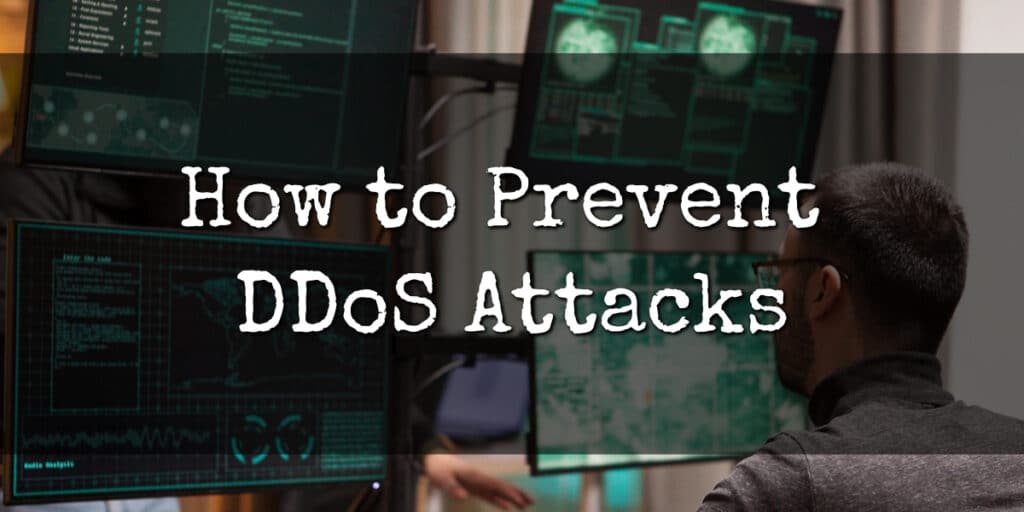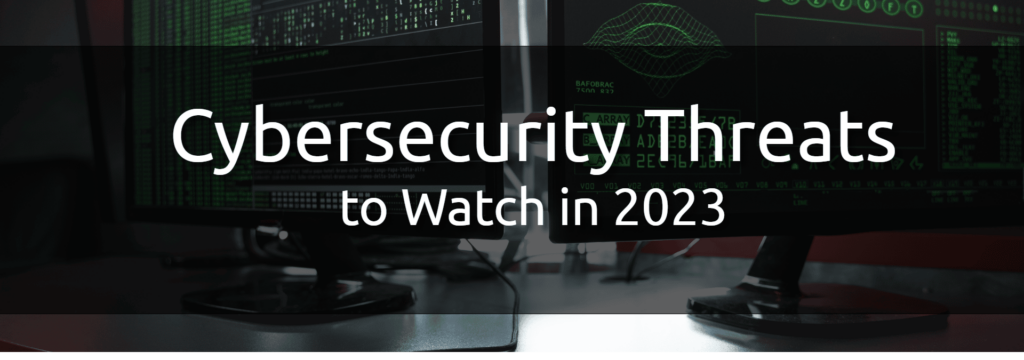Cybersecurity is more important than ever due to the rise of internet reliance in the modern business world. Distributed Denial of Service (DDoS) attacks are among the most significant threats to businesses. These attacks can have devastating consequences, from slowing website traffic to completely destroying a network.
This article will discuss how to prevent DDoS attacks from crippling your business.
On This Page:
What is a DDoS Attack?
A Distributed Denial of Service (DDoS) attack is a type of cyber attack that disrupts the normal functioning of a website or network by overwhelming the target server with a flood of traffic from multiple sources, rendering the system inaccessible to legitimate users.
DDoS attacks are often carried out by hackers who have a grudge against a particular website or company or by cybercriminals who want to extort money from their victims. These attacks can be devastating, bringing down entire networks and websites, causing significant financial losses, and damaging reputations.
How Do DDoS Attacks Work?

Distributed Denial of Service (DDoS) attacks occur in three stages.
- Reconnaissance – In the reconnaissance, or “recon” stage, attackers identify the vulnerabilities of the target system. This involves scanning the target network for weaknesses and vulnerabilities, such as outdated software or unsecured ports.
- Install – In the second phase, botnets are installed on numerous computers, providing attackers with a resource to overload the target system with heavy traffic. Botnets, networks of remotely controlled, compromised computers infected with malware, enable coordinated attacks on the targeted system.
- Attack – During the final stage, the botnet sends a large volume of traffic requests to the target server, overwhelming it and resulting in a DDoS attack. This flood of traffic can come from a variety of sources, including malware-infected computers or hijacked Internet of Things (IoT) devices.
Common Types of DDoS Attacks
DDoS attacks can be broadly categorized into four types: Volumetric Attacks, Protocol Attacks, Network Layer Attacks, and Application Layer Attacks. Each type targets different layers and aspects of a network, and they come in various forms.
Volumetric Attacks
Volumetric Attacks aim to consume the bandwidth of the target network or site. They overwhelm the network with a massive volume of data to cause disruptions.
- UDP flood attacks: Attackers send UDP packets to the target system, consuming all available bandwidth. UDP is a protocol for sending small data packets across a network, commonly used for online gaming and video streaming.
- ICMP (Ping) Flood Attacks: Attackers overwhelm the target resource with ICMP Echo Request (ping) packets, essentially blocking responses to legitimate traffic.
Protocol Attacks
Protocol Attacks are designed to exploit the procedures for managing data on a network. They aim to consume all the available resources of specific network infrastructure components like routers or servers.
- Syn flood attacks: Attackers create a large number of TCP connection requests, overwhelming the target system. This attack exploits a vulnerability in the TCP protocol, which establishes connections between computers on a network.
Network Layer Attacks
Network Layer Attacks occur at the network or transport layers of the OSI model. They target the network interface between the target server and the internet.
Network Layer attacks often include Volumetric and Protocol attacks such as UDP flood, ICMP flood, and SYN flood attacks mentioned above.
Application Layer Attacks
Application Layer Attacks, also known as Layer 7 attacks, target the layer where common internet requests occur. These attacks are often harder to detect as they mimic normal user behavior.
- HTTP flood attacks: Attackers flood the target server with HTTP requests, making the website inaccessible to legitimate users. This attack is often conducted by botnets, capable of sending thousands of requests per second to a target website.
- Slowloris Attacks: These attacks keep connections to the target system open as long as possible by sending partial HTTP requests, tying up the system’s resources, and preventing it from processing legitimate requests.
Other Notable Types of Attacks
- DNS Flood Attack: This attack targets the DNS servers of a website, overloading its ability to resolve and respond to requests, resulting in slowdowns or making the site unavailable.
- NTP Amplification Attack: In this attack, the attacker exploits the Network Time Protocol server to overwhelm a targeted server with traffic. This is achieved by sending a small forged packet that requests a large amount of data be sent to the target IP address.
- SSL/TLS-based Attacks: These attacks exploit the Secure Sockets Layer and Transport Layer Security protocols used to encrypt internet communication. The aim is to exhaust the resources of a server, making it unable to handle legitimate requests.
Assessing Your Business’s Vulnerability

Cyber attackers are constantly looking for vulnerabilities in your network that they can exploit to gain access to your sensitive information.
Identifying Weak Points in Your Network
There are several common weaknesses in your network that cyber attackers can exploit.
- Outdated software: If your software is not up to date, it may contain security flaws that attackers can use to gain access to your system.
- Poorly managed firewalls: If your firewalls are not configured correctly, they may be unable to detect and block malicious traffic.
- Unsecured IoT devices: These devices are often not adequately secured, which makes them an easy target for attackers.
- Lack of proper encryption and weak passwords.
Understanding Regulatory Requirements
In addition to identifying weak points in your network, it’s important to understand any regulatory obligations your business may have related to cybersecurity.
Depending on your jurisdiction and industry, there may be specific regulations that mandate certain protective measures or response protocols for DDoS and other cyber attacks.
Failure to comply with these regulations could result in fines or other penalties, so it’s crucial to stay informed and ensure your business’s cybersecurity measures meet all necessary requirements.
Recognizing Potential DDoS Attack Patterns
The best way to prevent DDoS attacks is to recognize them before they happen. Regularly monitor your network to identify unusual spikes in traffic that may indicate a potential attack.
Preventing DDoS Attacks

There are several strategies you can implement to protect your network from DDoS attacks.
Strengthening Your Network Infrastructure
One of the most important steps to prevent DDoS attacks is to strengthen your network infrastructure.
Make sure to limit the number of open ports on your firewall, implement SSL encryption, and use strong passwords to protect your devices.
Another important step is to update your software regularly. This includes your operating system, applications, and security software. Outdated software can have vulnerabilities that attackers can exploit to launch DDoS attacks.
Deploying DDoS Mitigation Solutions
Deploying DDoS protection solutions can also help protect your business from DDoS attacks. These solutions can absorb the attack’s impact and deflect it, allowing legitimate traffic to access your website. They can also help you identify and block suspicious traffic quickly.
One popular DDoS mitigation solution is a content delivery network (CDN). CDNs distribute web content across a range of locations, improving website performance by caching content closer to users and offloading traffic from the origin server. This makes it harder for attackers to overwhelm your system.
Another solution is a cloud-based DDoS protection service. These services use advanced algorithms to analyze traffic and identify patterns that indicate an attack. They can then block the attack before it reaches your network.
Cloudflare is a popular CDN with built-in DDoS protection.
Ensuring Proper Firewall Configuration
Firewalls are the first line of defense against cyber attacks. Ensuring your firewall is set up correctly is vital to your business’s cybersecurity. Proper firewall configuration can help prevent malicious traffic from entering your network. Firewalls can also be programmed to recognize and block suspicious traffic, including DDoS attacks.
Make sure to configure your firewall to block traffic from known malicious IP addresses and to limit the number of connections from a single IP address. You can also configure your firewall to block traffic from specific countries or regions.
Monitoring and Responding to DDoS Attacks

Establishing a DDoS Response Plan
A detailed DDoS response plan can help your business respond quickly and effectively during an attack. Your DDoS response plan should include instructions on how your team should detect and isolate the compromised device or network segment, identify the nature of the attack, and prepare a response plan to mitigate the attack’s impact.
It’s also important to have a communication plan in place to keep all stakeholders informed during the attack.
One important aspect of your response plan should be to identify and train a DDoS response team. This team should include members from IT, security, and network operations who can work together to detect and mitigate DDoS attacks.
Monitoring Your Network Traffic for Anomalies
Monitor your network traffic statistics regularly so you can quickly spot when network traffic exceeds the normal traffic volume. You can also use network monitoring tools to flag any unusual patterns that may indicate a DDoS attack. These tools can help you identify the source of the attack, the type of traffic being used, and the target of the attack.
Another effective way to monitor your network traffic is to use intrusion detection systems (IDS) or intrusion prevention systems (IPS). These systems can detect and block malicious traffic before it reaches your network.
Coordinating with Your Internet Service Provider (ISP)
Most IP networks that connect enterprises to the internet are provided by internet service providers (ISPs). Coordinating with your ISP can help you detect and mitigate DDoS attacks more effectively. ISPs usually have more resources and expertise to manage cyber attacks and can generally get ahead of the situation faster than you alone.
Many ISPs offer DDoS protection services that can help you mitigate the impact of an attack. These services can include traffic filtering, traffic scrubbing, and rerouting traffic to protect your network.
Recovering from a DDoS Attack
It’s essential to have a recovery plan in place to get your business back up and running in the event of a DDoS attack. Once the attack has been mitigated, assess the damage and initiate corrective actions where necessary. Restore any affected data, applications, or systems to minimize the impact of the attack.
Conducting a post-mortem analysis of the attack is also important to identify any weaknesses in your security posture and response plan. Use this analysis to update your response plan and improve your security posture to prevent future attacks.
Restoring Your Data
After initiating corrective actions, restore any affected data, applications, or systems to minimize the impact of the attack.
This process will be significantly smoother if you have been conducting regular backups of your important data.
Regular data backups, especially off-site or in the cloud, can speed up the recovery process and reduce the data loss that could occur from a DDoS attack.
Educating Your Team on DDoS Attack Prevention

Training Employees on Cybersecurity Best Practices
One of the most effective ways to prevent DDoS attacks is by ensuring that your employees are up to date on cybersecurity best practices.
Educate your staff on the proper management of devices, password hygiene, and social engineering tactics, and report any suspicious activity. Creating a culture of security awareness within your organization is essential, and your employees are your first line of defense against DDoS attacks.
Training your employees on cybersecurity best practices can significantly reduce the risk of a DDoS attack. Make sure that your employees understand the importance of strong passwords, two-factor authentication, and the dangers of clicking on suspicious links or opening attachments from unknown sources.
Encourage your employees to report any unusual activity, such as slow network speeds or unusual traffic patterns.
Encouraging a Culture of Security Awareness
Raise awareness about cybersecurity through training sessions and seminars. Educate your employees on the importance of implementing cybersecurity best practices. Employees should also know what to do in case of an attack and how to report any unusual activity.
Make sure that your employees understand the importance of keeping their devices and software up to date. Outdated software can leave your business vulnerable to cyberattacks, including DDoS attacks.
Encourage your employees to report any suspicious calls, emails, or messages they receive, and ensure they know how to verify the authenticity of any requests for sensitive information.
Staying Informed on the Latest DDoS Attack Trends
Cybercriminals are constantly adapting their methods, and DDoS attacks are no exception. It’s crucial to stay informed about the latest DDoS attack trends and techniques and implement measures to mitigate them.
Regularly review your cybersecurity infrastructure and ensure you have the latest security software and hardware in place.
Consider partnering with external cybersecurity consultants or services, who can perform regular audits, identify vulnerabilities, and suggest improvements.
Conclusion
In a nutshell, DDoS attacks present a significant threat to businesses, necessitating proactive prevention strategies. Such strategies involve the use of mitigation tools, regular network traffic monitoring, comprehensive employee cybersecurity training, and staying updated with the evolving landscape of DDoS threats.
As cyber threats continue to evolve, businesses must keep improving their cybersecurity defenses. By focusing on DDoS prevention, companies can protect themselves from the damaging effects of these attacks and minimize financial and reputational damage.
Frequently Asked Questions
How much can a DDoS attack cost?
The cost of a DDoS attack can vary greatly depending on the scale and duration of the attack, and the nature of the business affected. Costs can range from a few thousand dollars to millions. These costs can include loss of revenue due to downtime, the expense of mitigation services, potential ransom payments, and potentially even reputation damage leading to long-term loss of customers.
Why do people do DDoS attacks?
There are several reasons why someone might carry out a DDoS attack. It could be for financial gain, either through extortion or to disrupt a competitor. Others might do it for ideological reasons, such as cyberterrorism, or hacktivist groups attacking companies they disagree with.. Some people might even carry out these attacks simply for the challenge or for the fun of causing chaos.
Does a VPN protect you from DDoS?
A VPN can provide some degree of protection from a DDoS attack, but it’s not a complete solution. VPNs can mask your IP address, which is often targeted in DDoS attacks. However, if the attacker knows the IP of the VPN server you’re using, they could potentially attack that instead. Also, VPNs do not protect against all types of DDoS attacks, such as those targeting specific applications or services.
How long can a DDoS last?
The length of a DDoS attack can range from a few minutes to several weeks, with the average attack lasting about 24 hours. The duration often depends on the attacker’s resources and the effectiveness of the victim’s mitigation strategies.
Who is targeted for DDoS attacks?
Any business or organization with an online presence can be targeted for a DDoS attack. This includes e-commerce sites, banks, government institutions, healthcare providers, and even gaming services. Often, businesses that depend heavily on their online presence are most vulnerable, as any interruption to their services can have serious consequences.
Can you recover from a DDoS?
Yes, you can recover from a DDoS attack. Recovery involves identifying and mitigating the attack, then restoring normal operations. This often involves the use of specialized DDoS mitigation services. After recovery, it’s important to analyze the attack and improve defenses to reduce the likelihood or impact of future attacks. However, some effects of the attack, such as loss of customer trust, may take longer to recover from.



